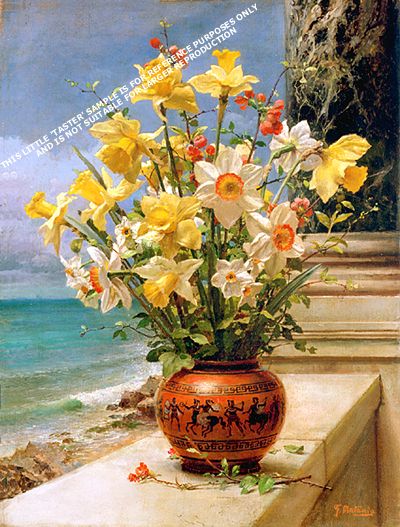|
361
'THE JOY OF SPRINGTIME'
by Fortunino Matania (1881-1963)
 Daffodils
are probably the most delightful herald of the new season.
After months without the brightness of fresh-cut flowers,
suddenly their golden trumpets are here to bring out the best
in all of us. Winter's long greyness can disappear within
seconds of being mesmerised with the sight of daffodils. And
the white blooms with their distinctive bright red trumpets,
are almost toot-tooting their presence for all to see. Daffodils
are probably the most delightful herald of the new season.
After months without the brightness of fresh-cut flowers,
suddenly their golden trumpets are here to bring out the best
in all of us. Winter's long greyness can disappear within
seconds of being mesmerised with the sight of daffodils. And
the white blooms with their distinctive bright red trumpets,
are almost toot-tooting their presence for all to see.
Here
we are witnessing a very unusual combination of what are normally
accepted as northern spring flowers, yet set in such an unusual
'il paradiso' view from a Mediterranean balcony. This surreal
setting perhaps was more of an aspiration by this homesick
Italian artist. The beautiful Minoan pot sets the bouquet
perfectly - its natural terra cotta hues enhancing the floral
contrasts.
As the turquoise sea disappears over the horizon, it makes
one feel envious of those who live within the property. This
too must surely be a magnificent palace - just the base of
one marble pillar is enough for us to imagine the classical
excellence that must surround us on all sides.
 So
this painting of 'Joy of Spring' is the interpretation of
just how vivid imagination can be, and our dreams really can
be fulfilled through artistic interpretation. So
this painting of 'Joy of Spring' is the interpretation of
just how vivid imagination can be, and our dreams really can
be fulfilled through artistic interpretation.
 Fortunino
was the son and student of his father, the artist Edward Matania.
Fortunino was born in Naples, Italy in 1881. He was a draughtsman
and miniaturist as well as painting in oils and watercolours.
He was very talented in pastel drawings too. He began his
career from the age of just 14 years old travelling to Milan
to draw for a magazine. Subsequently he worked in Paris and
then London illustrating for The Graphic and The Sphere. Following
his depictions of the First World War he was honoured by the
Italian Government. While living in London he exhibited extensively
at the R.A. and the R.I. and some of his work was purchased
by Queen Mary. When much younger, he became a contemporary
of John Singer Sargeant. Fortunino
was the son and student of his father, the artist Edward Matania.
Fortunino was born in Naples, Italy in 1881. He was a draughtsman
and miniaturist as well as painting in oils and watercolours.
He was very talented in pastel drawings too. He began his
career from the age of just 14 years old travelling to Milan
to draw for a magazine. Subsequently he worked in Paris and
then London illustrating for The Graphic and The Sphere. Following
his depictions of the First World War he was honoured by the
Italian Government. While living in London he exhibited extensively
at the R.A. and the R.I. and some of his work was purchased
by Queen Mary. When much younger, he became a contemporary
of John Singer Sargeant.

|
